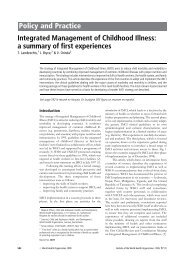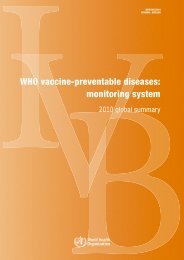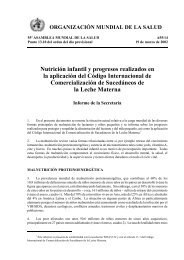IPDE - Extranet Systems - World Health Organization
IPDE - Extranet Systems - World Health Organization
IPDE - Extranet Systems - World Health Organization
Create successful ePaper yourself
Turn your PDF publications into a flip-book with our unique Google optimized e-Paper software.
36 J. H. Reich and G. de Girolamo<br />
PD. and it accounted for 45% of the total sample. The next most wmmon<br />
was asthenic PD.<br />
In the US on a selected day in 1986, there were a total of 3893 persons<br />
under care in some in-patient psychiatric facility, with a primary diagnosis<br />
of PD. This corresponded to 2.4% of the total number of in-patients<br />
on that date.41 In the same year there were 29,910 admissions with a primary<br />
diagnosis of PD. 1.9% of all admissions. The median length of hospital<br />
stay for in-patients with a diagnosis of PD was nine days. Among<br />
all those under out-patient care on the same day, there were 81,731 or<br />
5.9% of the total, with a diagnosis of PD. In the same year 136,903 people<br />
or 6.4% were admitted to out-patient care with a PD diagnosis.<br />
The epidemiological findings in treated samples are especially important<br />
if we bear in mind that the presence of a PD among those suffering<br />
from other mental disorders can be a major predictor of the natural history<br />
and treatment o~tcome.~<br />
Conclusions<br />
The epidemiology of PDs has not received the same amount of attention<br />
as that of many other psychiatric disorders. In the last few years the situation<br />
has changed, and we now have data on the prevalence of PD in the<br />
community and in psychiatric facilities. Community data come primarily<br />
from three studie~l~-~~ with a total sample of about 1300 subjects from<br />
two countries, Germany and the US. There are excellent national and<br />
cross-national epidemiological data on antisocial personality disorder,<br />
based on the same diagnostic methods. There are almost no data on other<br />
PDs from countries other than Germany and the US. The lack of studies<br />
from developing countries is especially noteworthy because the role of<br />
sociocultural factors has yet to be determined.<br />
One important methodological problem is that some PDs have a very<br />
low prevalence rate. Consequently, epidemiological surveys carried out<br />
among the general population may require very large samples in order to<br />
identify a sufficient number of cases to study demographic correlates and<br />
the association of PD with other psychiatric disorders.<br />
Many of the PDs are at an early stage of construct validation. Further<br />
research should probably follow the general recommendations for validating<br />
a psychiatric disorder. These include the need to delineate a proposed<br />
disorder from other disorders. Given the overlap of the PDs, this<br />
will be a challenging task. Another criterion is external validation, and<br />
there are a number of psychological tests and behavioural indicators that

















